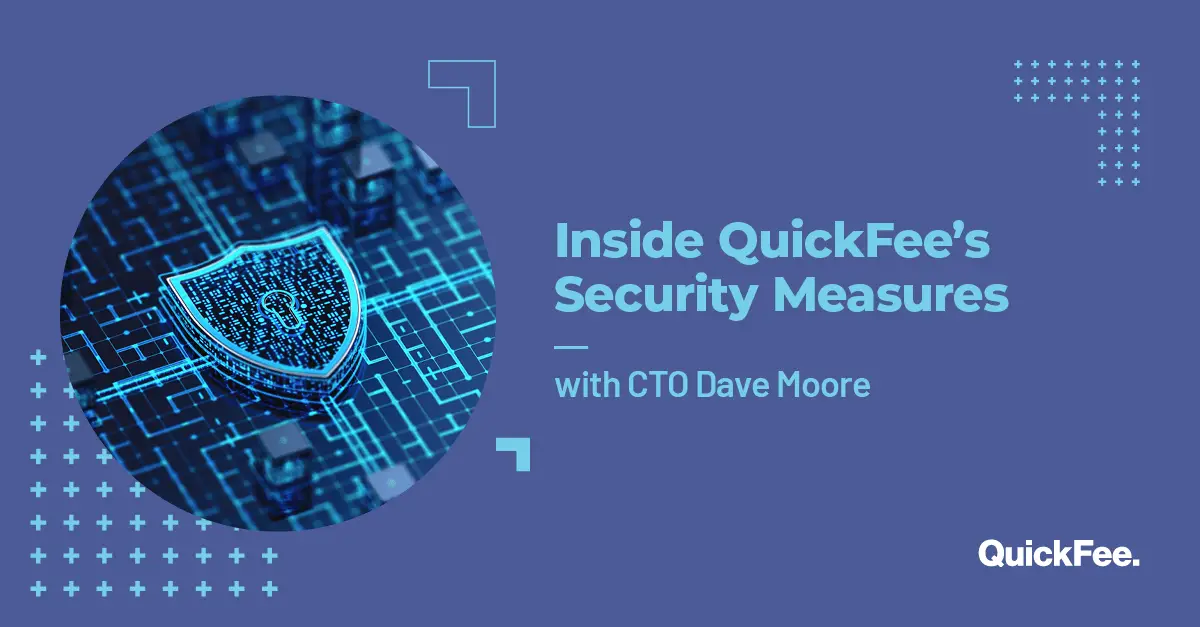Cybersecurity can be defined as the practice of protecting your hardware, software, and data systems from cyberthreats. But protecting your firm is about more than just setting up your technology and systems for success: It starts with recognizing that your company is always a target. When you acknowledge this reality, you have a completely different perspective on how to protect vulnerable systems and data.
Being a financial technology company automatically makes QuickFee a target, so we must take even more measures to protect our company and customers. In this post, I’ll break down the basics of QuickFee’s security measures as the Chief Technical Officer. You’ll also get useful tips on how you can better protect your own firm from threats.
7 Critical Measures to Protect Your Firm from Cyberthreats
1. Ongoing Training and Employee Education
Your first line of defense should always be an annual cybersecurity training for employees. Cyberattackers are constantly evolving their strategies to take advantage of human error and bias, as it’s easier to gain access through an employee’s account than to bring down the whole system from the outside. Phishing emails are the most common way to exploit employees, but there are hundreds of psychological tricks that will allow hackers and cyberattackers to gain access to valuable information.
This is why employee security education is a non-negotiable for your firm. While it can be challenging to find time to complete an annual training requirement, even as CTO, I can say that I learn new things every time!
2. Disaster Recovery Planning
There are two types of companies – those who have a robust disaster recovery (DR) plan and frequently test it, and those who eventually will. Unfortunately, most companies only worry about these things when it’s already too late. At QuickFee, we are always implementing and exercising robust DR plans in the event of a natural disaster, system failure, or ransomware attack to ensure we can continue normal business operations and protect our firms.
3. Embracing the DevSecOps Approach
DevSecOps stands for “Development, Security, and Operations” and it represents a new approach to the entire IT lifecycle where security is a shared responsibility across the Development and Operations cycle. It means that everything we do in our applications – from building to testing to monitoring – includes security steps as part of the Agile collaborative framework.
4. The Principle of Least Privilege
This principle states that only the people who need access to something have it. We highly restrict the number of people than can access to data and make sure it’s the data they need to do their job. It could be financial compliance-related (NACHA, PCI, PII) or company-related The best way to identify who needs access is to revoke it from everyone and see who requests it.
5. Robust Auditing Processes
Did you know that 60% of data breaches in 2022 happened internally? You could have the best security practices in place only to be breached by an internal resource. These types of breaches could be accidental (stolen laptop with company secrets) or intentional (collecting data for financial gain.)
At QuickFee we implement the principle of least privilege first, and then we augment that with auditing processes and ongoing check-ins. Whenever someone accesses sensitive information, it is logged, and a real-time alert is generated and routed to the correct person to evaluate the breach.
6. Following the Well-Architected Framework
All QuickFee applications run in Amazon Web Services or AWS. Amazon provides all users with the “Well-Architected Framework” or WAF, and security is a main pillar of those best practices. They also provide a playbook for how to build and maintain applications in a secure manner. By following the WAF and making sure during our design and implementation phases are in compliance, we’re significantly reducing the risk of a security breach.
7. Using Tools to Identify Weak Spots
Throughout the entire software lifecycle, it’s important to use industry standard tools that can identify weak areas and security threats – and then provide recommendations to fix them. ProwlerPro is our preferred tool in AWS, which runs a daily scan against all our environments and produces a nice dashboard with the findings and recommendations. In addition, we use DataDog for real-time dashboarding and alerting of all events, including security.
Final Thoughts: There Is No Finish Line
So when is the security work finished? The bad news is that there is no finish line: Security is a never-ending journey for your company. Technology changes constantly, people come and go, and new vulnerabilities are created. The good news, though, is that you can reduce your risk by making security a part of your “fiber” as an organization. Security is part of QuickFee’s cultural DNA and is a factor in everything we create.
Even when companies spend millions on our security measures, there’s no 100% guarantee against cybersecurity threats. With the seven measures outlined above, QuickFee is able to both prevent attacks and contain any security issues. By applying them, your firm can greatly reduce the chance of being the victim of a successful security attack.
Have more questions about QuickFee’s security measures? Contact our team at support@quickfee.com.
